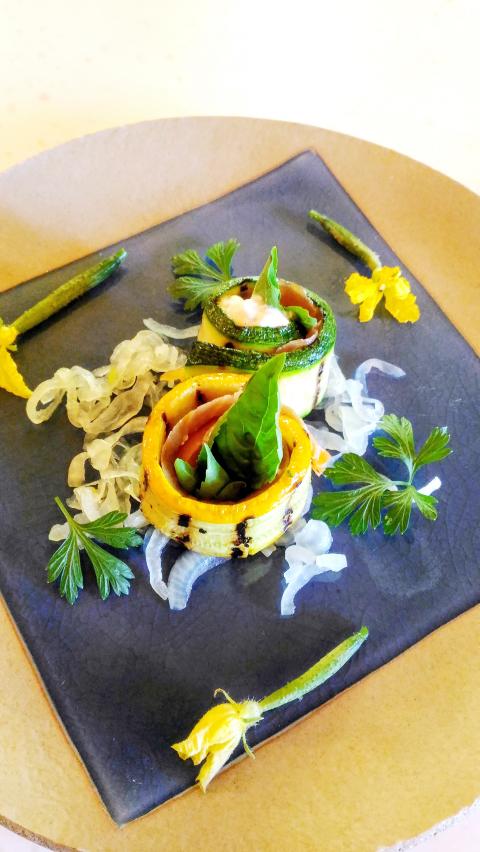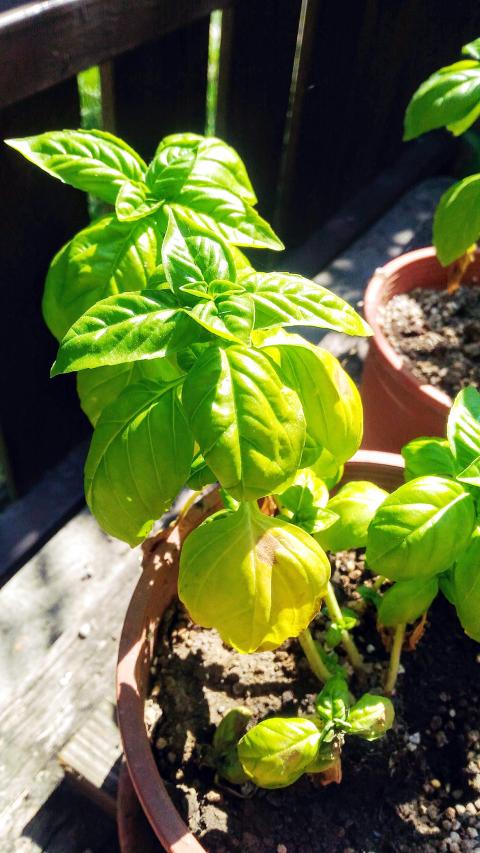Basil is one of the most aromatic of herbs, easily recognized, but often confusing in its variety of appearance and flavor. There are hundreds of types, the most immediately recognized being sweet basil, also called Genovese basil, the key ingredient in so many classic Italian dishes, and Thai basil, unsurprisingly a staple of Thai cuisine. The variety most sold in Taiwan under the generic name jiucengta (九層塔) is closer to Thai basil than it is to sweet, but there seems to be little consensus as to whether it is, strictly speaking, Thai basil or a variety of its own.
The name basil covers a wide territory of taste and aroma, and there is a large quantity of discussion of local food and recipe sites regarding questions like whether local basil can be used for pesto. It is basil after all. The short answer to that question is: No. Indeed my first introduction to local basil was just such an attempt, and while the result was not entirely inedible, the sharp, almost acrid flavor and pungent spiciness required considerable strength of character to ingest, and no amount of pine nuts and parmigiana was going to bring sweetness to the dish.
This is not to say that local jiucengta is an inferior type of basil, it is simply a different one, suitable to other preparations. It is perfect for the pungent Taiwanese eatery staple, three-cup chicken (三杯雞), and there is nothing better to provide a bit of zing to deep fried chicken pieces (鹽酥雞) and other tidbits at your local night market. It is also perfectly suited to sharpening the taste of most Thai dishes or sprinkled on top of Vietnamese pho. For Taiwan’s humid climate, it is the default basil, able to grow and produce abundant harvests of leaves even with minimal supervision. But leave it out of your bruschetta.

Photo: Ian Bartholomew
While sweet basil does not do so well in Taiwan, it is still relatively easy to grow, and offers a more delicate flavor that is perfect for salads and lightly seasoned dishes. It does not keep well, and the leaves will quickly oxidize once chopped. But washed and thoroughly dried, whole leaves can be kept for a couple of days in the fridge in an airtight container. Dried basil yields an insipid flavor, losing much of its pungency and vitality, but this has not prevented its sale as a dried herb — this may have some uses, but should not be mistaken as a suitable substitute for the fresh leaf. If you enjoy using sweet basil, it is best to grow it yourself. There are also a few methods of preserving its delicious flavor. Preservation in oil is the most common, but a much better method is to layer the leaves with salt. Neither method actually preserves the basil leaf, but keeps its flavor alive for use as an excellent flavoring for all kinds of dishes.
But nothing beats fresh sweet basil leaves, and even a whiff of its deeply complex perfume is enough to explain why it is sometimes referred to as the “king of herbs.” And more than simply tasting fantastic, it is also said to have anti-bacterial properties that actually makes the food you eat safer. It is particularly recommended as an addition to uncooked foods such as salads, as its essential oils have been show to retard the growth of various strains of bacteria that may cause intestinal discomfort when ingested. It is also a powerful anti-inflammatory, antioxidant and is recognized as having significant benefits for cardiovascular health. What more can you ask of something you put in your salad or pasta?
Ian Bartholomew runs Ian’s Table, a small guesthouse in Hualien. He has lived in Taiwan for many years writing about the food scene and has decided that until you look at farming, you know nothing about the food you eat. He can be contacted at Hualien202@gmail.com.

Photo: Ian Bartholomew
Smoked salmon rolls
Recipe
(serves two)
Fresh basil leaves provide a delicious punch to this simple dish. Having a couple of plants within easy reach of the kitchen counter is a great way to ensure that you always have some lovely leaves to toss into whatever you are cooking. The yogurt used in this dish is strained to provide greater thickness and a more intense flavor. If you make your own yogurt, this is easily done by placing the yogurt on some muslin in a strainer and leave it for three or four hours, resulting in an almost cream cheese-like consistency. This may not work with commercial yogurt as some brands seem to contain ingredients that prevent the separation of the whey from the curds.
Ingredients
200g smoked salmon
20 fresh basil leaves
1 zucchini
1 yellow squash
half an onion
100 ml yogurt, strained
zest and juice of half a lemon
four stems flat leaf parsley
salt and pepper
olive oil
Directions
1. Slice the zucchini and yellow squash lengthwise into slices about 0.5cm thick. Season generously with salt and pepper and brush with olive oil.
2. Heat a griddle and cook the zucchini and yellow squash for about two minutes a side, or until you get nice charred stripes. You might have to do this in two or three batches. Set aside and allow to cool.
3. Thinly slice the onion and sprinkle with salt. Set aside for about 20 minutes, until the onions start to release water. Squeeze the onions to press out as much liquid as possible.
4. Mix lemon zest and a splash of lemon juice to the yogurt. Season with salt and pepper.
5. Lay the slices of zucchini and yellow squash out on a tray. Place one long strip of salmon on it, then a dollop of yogurt and a couple of basil leaves. Roll it up. Avoid the temptation to overfill the rolls with salmon, as the flavor is best when the smoked salmon doesn’t dominate.
6. Mix the onions and flat leaf parsley and serve together with the salmon rolls.
Ian Bartholomew runs Ian’s Table, a small guesthouse in Hualien. He has lived in Taiwan for many years writing about the food scene and has decided that until you look at farming, you know nothing about the food you eat. He can be contacted at Hualien202@gmail.com.

June 2 to June 8 Taiwan’s woodcutters believe that if they see even one speck of red in their cooked rice, no matter how small, an accident is going to happen. Peng Chin-tian (彭錦田) swears that this has proven to be true at every stop during his decades-long career in the logging industry. Along with mining, timber harvesting was once considered the most dangerous profession in Taiwan. Not only were mishaps common during all stages of processing, it was difficult to transport the injured to get medical treatment. Many died during the arduous journey. Peng recounts some of his accidents in

“Why does Taiwan identity decline?”a group of researchers lead by University of Nevada political scientist Austin Wang (王宏恩) asked in a recent paper. After all, it is not difficult to explain the rise in Taiwanese identity after the early 1990s. But no model predicted its decline during the 2016-2018 period, they say. After testing various alternative explanations, Wang et al argue that the fall-off in Taiwanese identity during that period is related to voter hedging based on the performance of the Democratic Progressive Party (DPP). Since the DPP is perceived as the guardian of Taiwan identity, when it performs well,

A short walk beneath the dense Amazon canopy, the forest abruptly opens up. Fallen logs are rotting, the trees grow sparser and the temperature rises in places sunlight hits the ground. This is what 24 years of severe drought looks like in the world’s largest rainforest. But this patch of degraded forest, about the size of a soccer field, is a scientific experiment. Launched in 2000 by Brazilian and British scientists, Esecaflor — short for “Forest Drought Study Project” in Portuguese — set out to simulate a future in which the changing climate could deplete the Amazon of rainfall. It is

Artifacts found at archeological sites in France and Spain along the Bay of Biscay shoreline show that humans have been crafting tools from whale bones since more than 20,000 years ago, illustrating anew the resourcefulness of prehistoric people. The tools, primarily hunting implements such as projectile points, were fashioned from the bones of at least five species of large whales, the researchers said. Bones from sperm whales were the most abundant, followed by fin whales, gray whales, right or bowhead whales — two species indistinguishable with the analytical method used in the study — and blue whales. With seafaring capabilities by humans